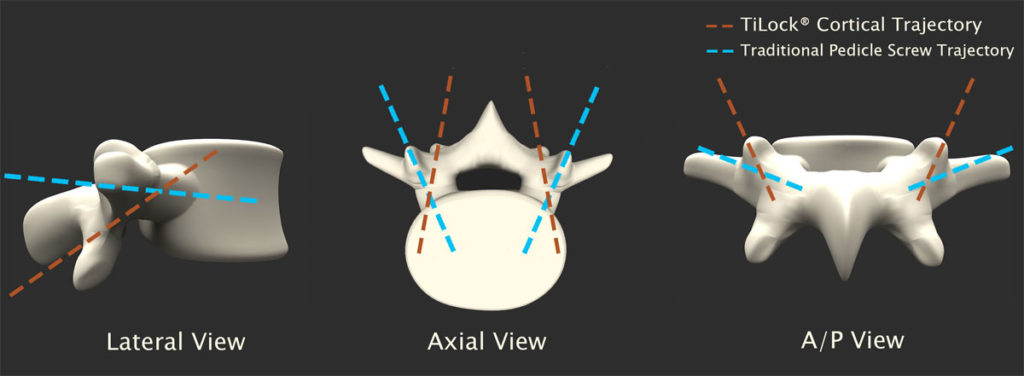As spinal surgery techniques evolve, there’s a clear trend toward approaches that reduce recovery time, minimize tissue damage, and enhance patient outcomes. The Midline Pedicle Screws Approach (MPSA) exemplifies this shift by combining the structural benefits of traditional pedicle screw fixation with the advantages of minimally invasive surgery. The Midline Fixation Procedure is designed to achieve more cortical bone purchase in the medial to lateral trajectory when compared to traditional pedicle screws. It takes no more time and clarifies the exposure of the lumbar transverse processes and intertransverse region. MidLine procedure minimize disruption to the nerves, muscles and tissue surrounding the surgery site.
What Makes the Midline Pedicle Screws Approach Different?
The MPSA is centered around a single midline incision along the back, providing direct access to the spinal column. Unlike traditional, more invasive techniques, this method greatly reduces the impact on muscles and surrounding tissues, translating to a less demanding recovery period for patients.
Let’s explore what makes this approach so effective:
- A Strategic Midline Path:
- Reduced Trauma: The MPSA employs a single incision along the spine’s midline. This natural pathway allows the surgeon to reach the spine with minimal disturbance to the surrounding muscle tissue. The result? Less postoperative pain, a lower risk of complications, and a more manageable recovery period.
- Enhanced Access: The midline path gives the surgeon clear visibility for precise pedicle screw placement without needing extensive muscle retraction, unlike traditional open procedures.
- The Role of Pedicle Screws in Stabilization:
- Reliable Fixation: Pedicle screws are vital in spinal fusion surgeries, providing a stable anchor by securing screws through each vertebra’s pedicle. This fixation keeps the spinal segments stable, preventing unnecessary movement and allowing the bones to fuse naturally.
- Versatility: Pedicle screws offer flexible placement options and are compatible with various spine conditions that require additional support. In the MPSA, their placement is even more precise, thanks to the direct access that the midline incision provides.
- Advantages of the Midline Pedicle Screws Approach:
- Less Invasive, Less Painful: MPSA’s minimally invasive nature significantly reduces tissue disruption. Patients typically report less pain, a shorter hospital stay, and a quicker return to normal activities than traditional open surgeries.
- Safer Recovery: By limiting muscle retraction, the MPSA minimizes tissue damage, which often translates into lower blood loss during surgery and fewer risks of postoperative complications.
- Improved Patient Experience: This approach also offers the benefit of a smaller scar along the midline, which tends to be more cosmetically appealing for patients concerned about visible scarring. Coupled with faster recovery, MPSA often results in a higher satisfaction rate.
- Ideal Candidates for the MPSA:
- Older Adults and Osteoporotic Patients: The MPSA is especially well-suited for patients with weakened bone structures, as it minimizes the stress on surrounding tissues while offering a reliable, durable stabilization option.
- Patients with Degenerative Conditions: Those with degenerative disc disease, spondylolisthesis, and similar conditions that cause spinal instability benefit from the enhanced support and reduced surgical impact of the MPSA.
How the MPSA Compares to Traditional Approaches
While traditional spinal fusion techniques have a solid record of success, they often involve extensive muscle retraction, longer incisions, and more postoperative pain. The MPSA, in contrast, uses a smaller, more centralized incision and avoids excessive muscle disruption, reducing the recovery time and enhancing overall patient comfort.
For patients and healthcare providers seeking a spine stabilization option that prioritizes both effectiveness and comfort, the MPSA offers a compelling alternative to conventional techniques.
The Future of Spinal Surgery: MPSA as a New Standard of Care
The Midline Pedicle Screws Approach represents a significant leap forward in spinal surgery, bringing together the best aspects of traditional stability techniques with modern, patient-centered surgical principles. Its minimally invasive nature and reliable results make it a valuable choice for surgeons and patients, offering stability without the prolonged recovery often associated with spine surgery.
As demand for minimally invasive solutions continues to grow, MPSA is setting a new benchmark for what patients can expect in terms of recovery, stability, and overall satisfaction. This approach doesn’t just represent an incremental improvement—it’s a rethinking of how spinal surgeries can be conducted with patients’ long-term health and well-being in mind.
- Please learn about the Midline procedure from the Medtronic Brochure: MIDLF.SGT.Medtronic.pdf
- Midline cortical screws trajectory:

Which are the main Midline Cortical Systems?
Featured:

- TiLock Cortical Spinal System (Genesys Spine)
- Ventotene (Tsunami Medical)
- ART Fixation System (NGMedical)
- Quatro Quad Lead Thoracolumbar Screws (Normmed)
Other Systems:
- CentraFix Midline Fixation System (Corelink-Zavation)
- Arsenal CBx (ATEC)
- CD HORIZON® SOLERA™ Cortical Fixation (Medtronic)
- CREO MCS® Stabilization System (Globus Medical)
- CENTERLINE Thoracolumbar Spinal System (Life Spine))
- Controvolte Spinal Fixation System (Neurostructures)
- CorticaLINK Cortical Screws (LinkSPINE
- Fortress™ Pedicular Fixation (Spineology)
- JANUS™ Midline Fixation Screw (Orthofix)
- LineSider Modular-Cortical System (Accelus)
- MySpine MC (Medacta)
- Mariner Midline (Seaspine-Orthofix)
- PressON System (Nexus Spine)
- Reform® MC (Precision Spine)
- Trend II (Biomech)
- Xia CT (Cortical Trajectory) (Stryker)
- VIPER (Johnson&Johnson)
- Zavation Cortical Screw (Zavation)
###
We have updated this list with the Brochures, Surgical Techniques, and Videos available. We hope you find it useful and we appreciate and welcome any suggestions or comments. We may have missed some of the information or it may be inaccurate. In that case, we apologize for this. Please contact us and let us know.
All video parts, images, and documents related to the products are the sole property of the different companies. All the information is for Educational purposes only! No copyright infringement intended. We encourage you to contact us if you have any comments or suggestions or if you want us to include/remove your videos, images, or brochures. Please contact us at: [email protected]
